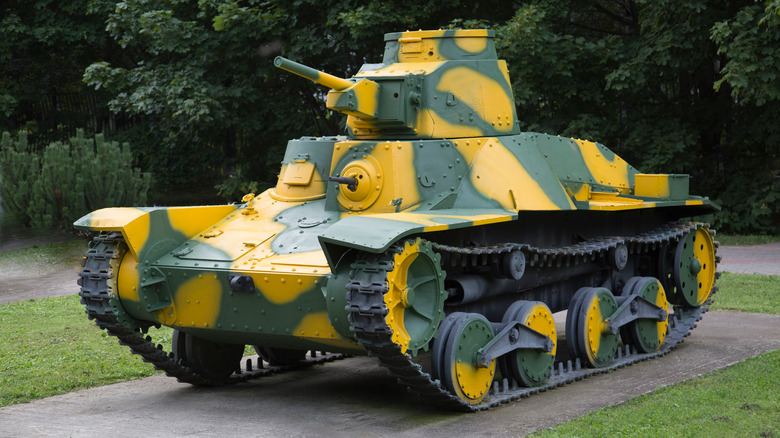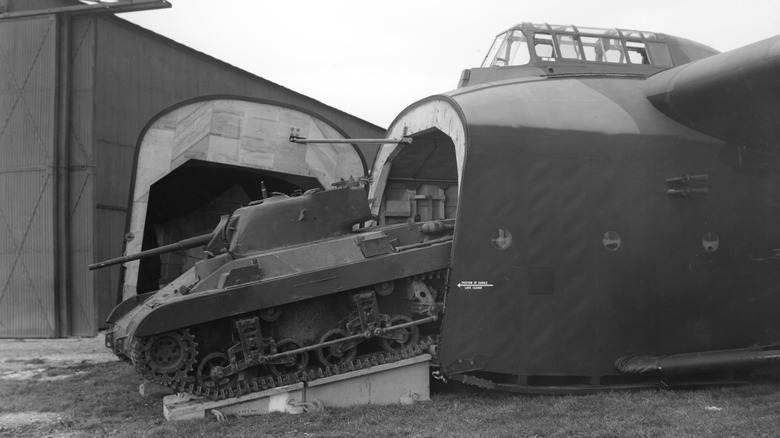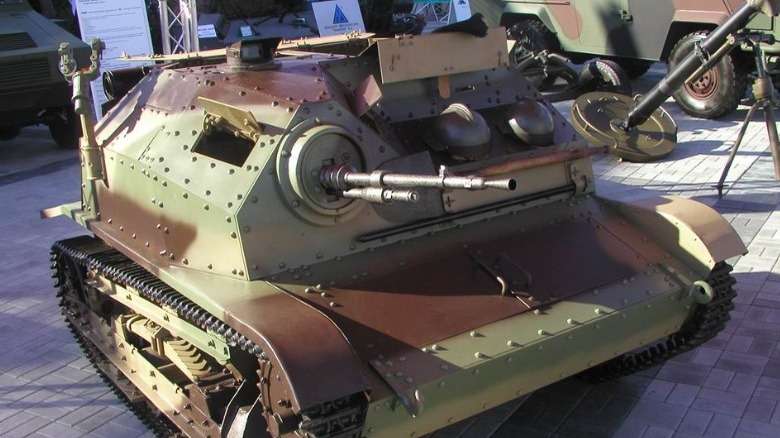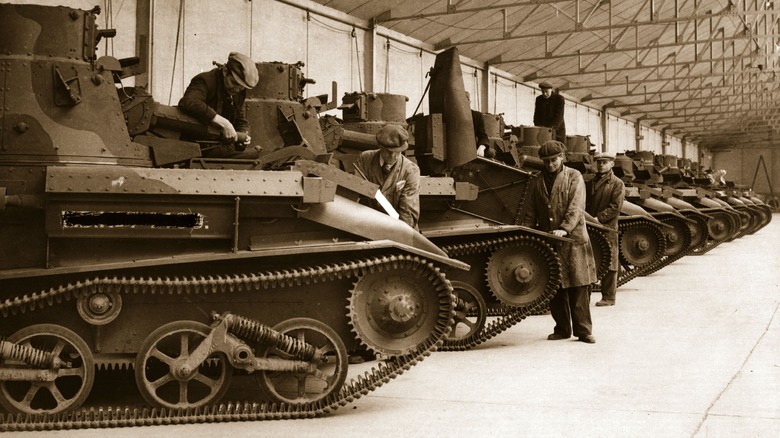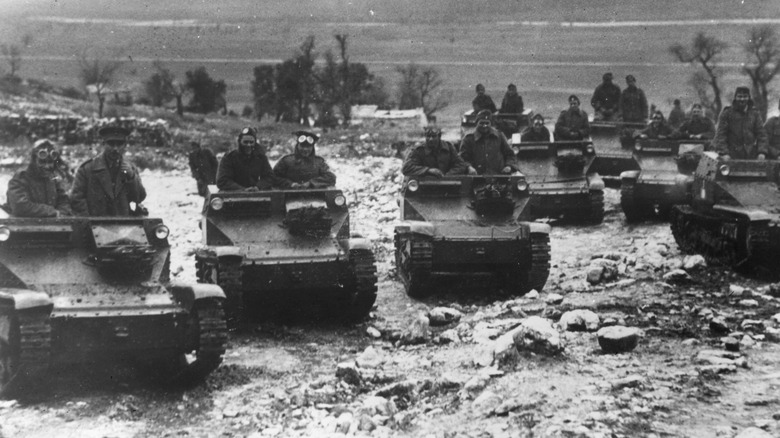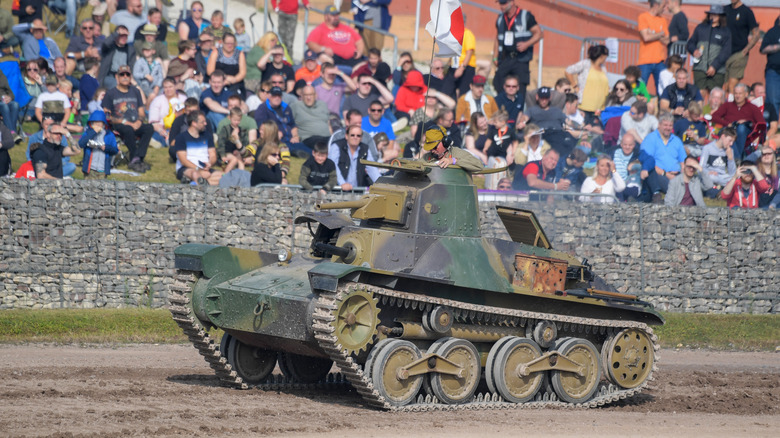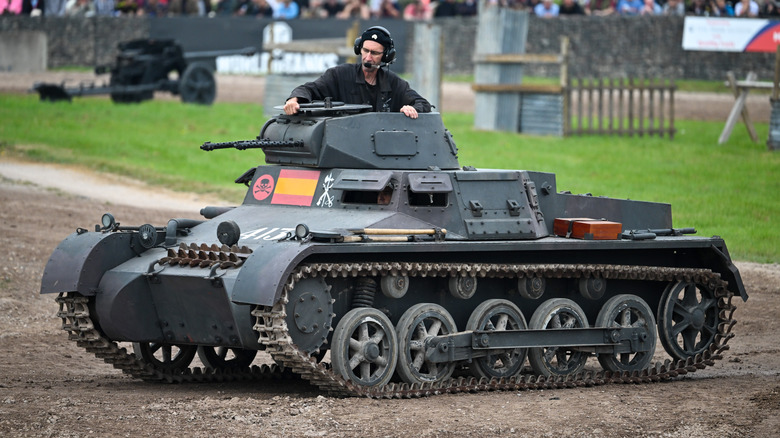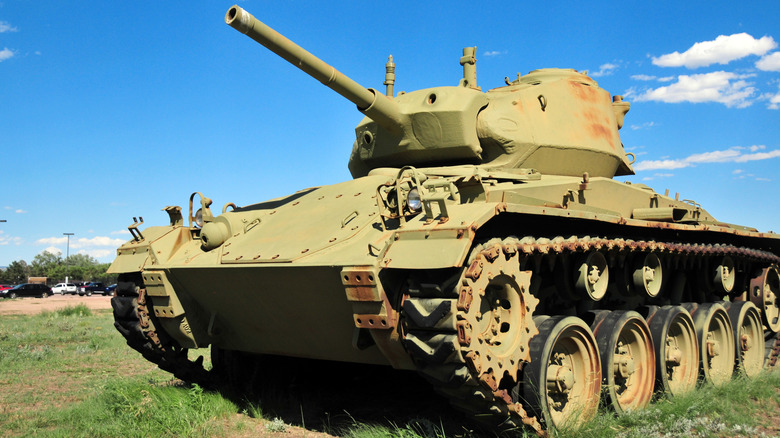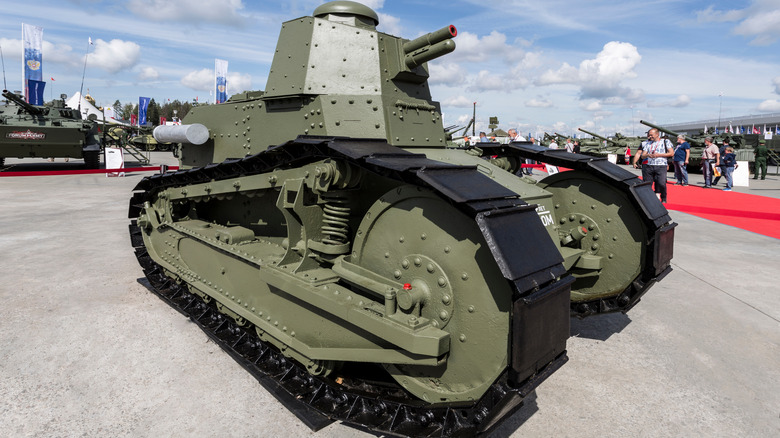8 Of The Smallest Military Tanks Ever Built
Tanks are generally known for being hulking machines of steel, operating as moving fortresses that can withstand a huge amount of damage and deal out carnage to enemy targets. The largest tanks ever built are massive weapons of war that can weigh dozens of tons. It is not unusual for modern main battle tanks to be as heavy as 50 or 60 tons.
Of course, not every tank is quite as huge as that — tanks from years gone by often came in a wider variety of sizes. While main battle tanks offer a combination of speed, armor, and heavy weaponry, tanks from the past often had more specialized roles. Some were light reconnaissance tanks intended to be agile, while others were heavy anti-tank machines that carried large cannons.
These are some of the smallest examples of tracked armored vehicles. They may not have been the most expensive tanks, but they could still pack a punch when needed.
M22 Locust
It makes a lot of sense that the M22 Locust would be small, as the American-made tank was specifically intended to be an airborne unit that could drop onto the battlefield. Development began in 1941 at the insistence of the British government, who wanted a light armored tank that a glider could carry. The hope was that such a vehicle would then be able to provide support to troops parachuting behind enemy lines.
Several tanks that may have been a fit for this type of role already existed, but British authorities wanted something dedicated to this specific job. Alternatives such as the Light Tank Mark VII Tetrarch were dismissed, and the U.S. began work on what would become the M22 Locust. By 1945, more than 800 had been produced and the finished design was small enough to be transported by a Douglas C-54 Skymaster aircraft or a General Aircraft Hamilcar glider.
The tank weighed just 16,400 pounds, barely 13% of the weight of a modern M1 Abrams main battle tank. In total, it was just over 12 feet long, 7 feet wide, and some 6 feet tall, requiring a crew of three people to operate. The small size didn't make the tank a pushover, though, as it came armed with an M3 37 mm anti-tank gun and a 7.62 mm Browning machine gun, along with just under half an inch of armor.
TKS
The TKS is a type of tankette developed by Fabryka Samochodów PZInż for use by the Polish military. Like most tankettes, this was a small tracked armored vehicle mainly meant for providing firepower support to infantry troops. It didn't have the kind of weaponry and armor plating you'd expect from a normal tank and was often used as a reconnaissance vehicle thanks to its agility
Not much larger than a car, the TKS was around 2.5 tons in weight and only 8 feet, 6 inches long. Up to two people could fit inside the tank, which was just 4 feet, 4 inches tall and 5 feet, 10 inches wide. The vast majority of this particular tankette was equipped with a 7.92 mm machine gun, although a few models did have a 20 mm main gun capable of damaging other armored vehicles.
The TKS was manufactured during the 1930s and made up the vast majority of Poland's armored divisions. However, the vehicle's small size and limited firepower led to it being overwhelmed by German forces during the invasion of Poland in 1939. Surviving TKS tanks were captured by both German and Soviet troops and used in support roles for the rest of the Second World War.
[Featured image by Polish Ministry of National Defence via Wikimedia Commons | Cropped and scaled | Public Domain]
Mark VI Light Tank
Like many other of the smallest tanks that have ever been constructed, the Mark VI Light Tank was active during World War II. Designed and manufactured by Vickers-Armstrongs, the first model entered active service in 1936 and over 1,500 were produced until it was discontinued in 1940. While no more were produced during the war, they remained in active service up until the 1948 Arab-Israeli War, where some of the tanks were utilized by Egypt. The vast majority of Mark VI Light Tanks were used by the British Army alongside Commonwealth allies such as Australia, New Zealand, and Canada.
While this light tank was small compared to its heavier and more powerful counterparts, the Mark VI Light Tank was not only built for reconnaissance but also warfare. The tank featured a 50 caliber Vickers machine gun often used as an anti-aircraft weapon, alongside a smaller 7.7mm machine gun. Along with a range of 120 miles and a maximum top speed of 35 mph, it was capable enough to offer a serious threat on the battlefield.
The original version of the tank weighed just 4.9 tons and was 13 feet long, with a width of 6 feet, 10 inches and a height of just over 7 feet. Despite that small size, it still took a crew of three people to operate.
Carro Veloce 33
The Carro Veloce 33 — otherwise known simply as the L3/33 — is an Italian tank that was developed during the early 1930s and eventually went on to serve a significant role for Italy's military during the Second World War. Manufacturer Ansaldo based the design on the British Carden Loyd tankette and built more than 2,000, although some were variants with slightly different weaponry and armor as part of a retrofit to modernize the tank.
The L3/33 saw action during the Second Italo-Ethiopian War and then prominently in World War II. It was involved in warfare with Axis powers in European countries such as Spain, France, and Russia, as well as in Italy's campaigns in Africa against British colonial forces. However, there is little information about how well the tank performed in combat and how much action it saw in the various theaters of war during this time.
Thanks to the fact it was based on a tankette, the Carro Veloce 33 was very small even for a light tank of that period. It weighed less than 3 tons and could only carry a crew of two people. That's because it was under 10 feet in length and less than 5 feet wide and 4 feet high. It was also limited in terms of firepower, with a single 6.5 mm machine gun acting as the main weapon. Meanwhile, welded armor with a maximum thickness of 12 mm provided little protection against anti-tank weaponry.
Type 95 Ha Go
Continuing the trend of lightweight and small tanks from the 1930s, the Japanese Type 95 Ha Go light tank first entered service in 1935 after testing in 1933 and 1934. It saw action just a few years later in the Second Sino-Japanese War when the conflict broke out in 1937 and the tank also took part in the Battles of Khalkhin Gol, as part of a wider confrontation between Japan and the Soviet Union. Following Japan's entry into World War II, the Type 95 Ha Go was deployed to more locations.
During the 1930s, Japan recognized that it needed to keep pace with other nations and include armored vehicles that could integrate into infantry divisions. Pre-existing tanks like the Type 89 Medium tank were unable to match the speed of typical infantry vehicles, so the country set about developing a faster and more mobile tank. The end result was the Type 95 Ha Go, which could travel at 28 mph on even terrain and had a range of around 130 miles.
Like many light tanks, the Type 95 Ha Go was not intended to be used in tank warfare. Instead, it was designed to provide infantry support and be effective against enemy troops. It did, though, have a 37 mm tank gun in addition to two 7.7 mm machine guns. These were operated by a crew of three, who commanded the 7.4 ton vehicle that was a little over 14 feet long and around 7 feet wide and high.
Panzer I
The Panzer is a polarizing series of tanks. The German line of armored vehicles ranged from fast and agile tanks that overwhelmed enemies to tanks that were massive, impractically heavy failures. The Panzer I was the first in this series produced by Germany in the build up to the Second World War. Development began in the 1930s and the tank was officially known as the Panzerkampfwagen I. It would eventually be surpassed and replaced by different variants, many of which were heavier and stronger.
The tank was initially only meant to be a training vehicle but its agility impressed German military leaders and, along with the Panzer II, it was widely used as part of the German Blitzkrieg strategy. With an operational range of 120 miles and a top speed of 23 mph, it could quickly maneuver into position and surprise enemy forces. The Panzer I saw action during the Spanish Civil War and in various locations during World War II,
The small size and weight of the Panzer I meant that it was ineffective against other tanks, especially those featuring anti-tank weaponry. With thin armor and a complement of two 7.92 mm MG 13 machine guns, it was useful for fighting against and suppressing infantry troops. That's why it weighed just 5.4 tons and was a little over 13 feet long and 7 feet wide, only providing enough space for a crew of two.
M2 Light Tank
The American M2 light tank was developed and manufactured during the peaceful time between the end of the First World War and the outbreak of the Second World War. Less than 1,000 were built, with production ending by 1942 in favor of more effective tanks with thicker armor, more firepower, and a still-reasonable top speed.
Despite having a large number of the M2 light tanks available, the U.S. military didn't use them extensively during the Second World War. In fact, the tank's only actual combat came during the Pacific conflict with Japan, although how widely it was used even in that theater is unclear. The basic chassis of the tank was the basis for the M3 Stuart and the M4 Tractor, both of which were more successful.
Original versions of the M2 were equipped with a heavy machine gun, although the later M2A4 variant was fitted with the 37 mm M3 anti-tank gun in an attempt to make it more effective against armored targets. The tank also carried up to five 7.62 mm machine guns and could reach a top speed of 36 mph. In terms of size, it was one of the larger light tanks from the time period but still small by modern standards. It had a total weight of 11.6 tons, was around 8 feet tall and wide, and had a length of 14 feet, 6 inches.
Renault FT
Often known as the FT17, the French Renault FT light tank first emerged during the closing stages of the First World War. In many ways, it set the standard for the modern tanks we see today and is among the most impressive tanks of all time, with the French design having a configuration that is still used today. This included a rotating turret and separate compartments for the engine and crew. 3,000 Renault FTs were produced, with the vast majority of them coming in the years after World War I.
Regarded as an early success, the Renault FT was exported to countries around the world and formed the basis for many tanks of the time period. Yet, by the time that war broke out again in Europe, it was outmatched by the more advanced tanks developed in the 1930s. France had largely replaced them with tanks like the Renault R-35 and R-40, but they were still relatively common as support vehicles.
Weighing only 6.5 tons, the Renault FT was 16 feet, 5 inches long, 5 feet, 9 inches wide, and exactly 7 feet tall. It held a crew of two and could reach a top speed of just 4.3 mph despite being so light and had a short range of only 37 miles. Adding to the fact that it was obsolete by the 1930s was its main armament, which consisted of one of several types of machine guns that were ineffective against other tanks.
